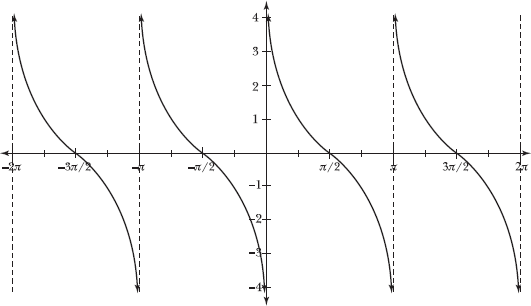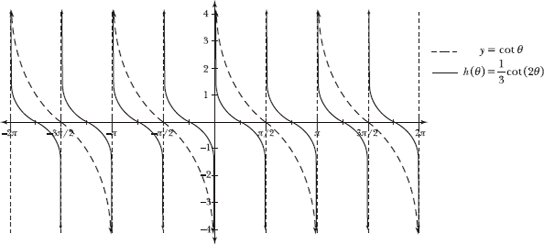Cotangent
A reflection of tangent
6.6 Graph f(θ) = cot θ on the interval –2π ≤ θ ≤ 2π and identify the period of f(θ).
Recall that f(θ) = cot θ is defined as the quotient of cos θ and sin θ. Therefore, it is equal to 0 (and intersects the x-axis) whenever cos θ = 0 and is undefined whenever sin θ = 0.

Like the graph of y = tan θ, the graph of f(θ) = cot θ passes through the point (π/4, 1), as demonstrated below.
![]()
As illustrated in the graph of cot θ, one period of the graph lies between vertical asymptotes θ = 0 and θ = π. Therefore, the period of f(θ) is the distance between those θ-values.
![]()
Thus, the graphs of tangent and cotangent both have the same period, π.
The graph of f(θ) = cot θ has vertical asymptotes at each multiple of π. Hence, the domain of cot θ is all real numbers such that θ ≠ kπ, where k is an integer. Like the graph of y = tan θ, the graph of f(θ) = cot θ increases and decreases without bound, and any horizontal line drawn on the coordinate plane intersects the graph. Thus, the range of f(θ) is all real numbers.
cot θ is not defined at ![]()
6.8 Graph j(θ) = cot (–θ) + 2.
Compared to the untransformed function y = cot θ, the input of j(θ) is multiplied by –1 and 2 is added to the function value. Therefore, to graph j(θ), you reflect the graph of y = cot θ about the y-axis and move it up two units.

6.9 Graph ![]() .
.
All of the points on h(θ) are one-third as high as the corresponding points on the graph of y = cot θ. Furthermore, two periods of h(θ) lie in the interval 0 < θ < π, where only one interval of y = cot θ lies.


6.10 Create a function g(θ), a transformation of y = tan θ that coincides with the graph of f(θ) = cot θ.
Reflecting the graph of tangent across the x-axis and then moving it to the left π/2 units produces the graph of f(θ) = cot θ. Thus, the graph of g(θ) = –tan (θ + π/2) coincides with the graph of f(θ).
![]() and
and ![]() are other correct answers.
are other correct answers.
Note that there are numerous correct answers to this problem. You can reflect the graph of y = tan θ across either the x- or the y-axis, and you can shift the reflected graph π/2 units to the left or the right.
